Posts Tagged ‘cat’
FIP is not a contagious disease!
Friday, March 6th, 2009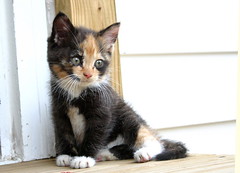 If your family includes cats or you know someone who lives with cats, please read this. I’m wandering back to the side of western medicine but this is a topic dear to my heart.
If your family includes cats or you know someone who lives with cats, please read this. I’m wandering back to the side of western medicine but this is a topic dear to my heart.
When I was working at the shelter I once got a voice mail from a client who had adopted a cat from us who came down with FIP and died. She was calling because she was angry that we had not tested for it and mentioned that her vet was recommending she euthanize her other two cats because they had been exposed and would most certainly come down with it and die. Of course I couldn’t get a hold of her and two of us spent the rest of the day frantically trying to reach her before she killed her two other cats. Luckily we did reach her in time.
FIP or Feline Infectious Peritonitis is one of the most misunderstood diseases in veterinary medicine. It is not contagious but it is a mutation of a contagious disease. It can not be diagnosed in a living cat yet there is a “FIP test”. There is a vaccine but it doesn’t work in most cats and there is some thought that it can actually help to induce FIP.
So let’s start at the beginning.
There is a virus in cats called Feline Coronavirus. This virus usually doesn’t cause illness or if it does just a little diarrhea or intestinal inflammation. It targets only gut cells. It is very common. Up to 80% of cats have been exposed to it and show an antibody titer. In multiple cat households and shelters and catteries up to 100% of cats have been exposed to it.
Sometimes for reasons that we do not know this virus mutates or changes into FIP, kind of like what happened to the Gremlins when they got wet. We think it is related to a weak immune system but we aren’t sure. FIP can attack any cells in the body by working through the white blood cells and it does, causing many symptoms such as a bloated and fluid filled abdomen, diarrhea, vomiting, a fever, lethargy, poor appetite, problems breathing and sometimes brain inflammation. Almost all cats with FIP die.
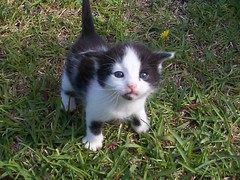 Occasionally two cats from the same household die of FIP. We used to think one had caught FIP from the other. However recently when researchers have studied where the mutation is in the virus they have found that the mutation will be different in each cat.
Occasionally two cats from the same household die of FIP. We used to think one had caught FIP from the other. However recently when researchers have studied where the mutation is in the virus they have found that the mutation will be different in each cat.
What does this mean?
It means that each mutation happened independently within that cat’s body. If they were passing the mutated FIP virus the mutation would be the same in each animal. This means that the FIP virus is not being passed once it mutates and is not contagious.
Why are cats is multiple cat households more likely to get FIP then?
Multiple cat households have a higher rate of coronavirus in them. The more coronavirus shed in a cat’s feces and picked up by other cats, the greater the chance there is for a mutation to FIP.
So how does a vet test for FIP?
There is a titer test called the FIP test. The only problem is that it tests for coronavirus not for FIP. Usually cats with FIP will have a high coronavirus titer but not always. And many cats without FIP will have a high titer. So a positive “FIP test” may point towards a diagnosis of FIP but also may not.
If a cat comes in with fluid in its abdomen which is common in FIP cats, the best test is a protein ratio run on the abdominal fluid. Most vets will also run bloodwork to test protein levels.
A high protein level in abdominal fluid with a low albumin/globulin (two proteins we look at) ratio with a high globulin level on bloodwork, and a high FIP/corona titer (positive FIP test) usually point towards FIP. That is the closest we can come. And many cats with FIP do not have all the above.
So why is there a vaccine if this is not a contagious disease?
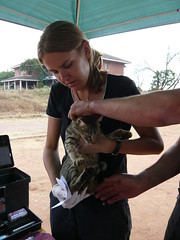 The short answer is because we used to think it was. The FIP vaccine will work to prevent coronavirus in about 60-80% of the 20% of cats that have not been exposed to coronavirus ever. Or about 12-16% of cats. It will not work if cats have been exposed to coronavirus. In addition there is some thought that if the cat has coronavirus in its body the vaccine could induce that coronavirus to mutate to FIP. So the vaccine works in 12-16% of cats but may actually induce disease in the ones it doesn’t work for. Hmmm. Not very good odds if you ask me.
The short answer is because we used to think it was. The FIP vaccine will work to prevent coronavirus in about 60-80% of the 20% of cats that have not been exposed to coronavirus ever. Or about 12-16% of cats. It will not work if cats have been exposed to coronavirus. In addition there is some thought that if the cat has coronavirus in its body the vaccine could induce that coronavirus to mutate to FIP. So the vaccine works in 12-16% of cats but may actually induce disease in the ones it doesn’t work for. Hmmm. Not very good odds if you ask me.
There is no good treatment for FIP beyond supportive care and most cats with it will die within a year or often times much less. In multiple cat households cleanliness, especially of litter boxes, can help cut down on the level of coronavirus, which helps prevent FIP.
Here’s some interesting resources on FIP
Wikipedia article on Feline Infectious Peritonitis
FAB on FIP
Cornell Feline Health Center FIP
Comments are closed on this article. There are only so many ways I can say that FIP is not contagious. It is not.
Basil gets his acupuncture among friends
Friday, March 6th, 2009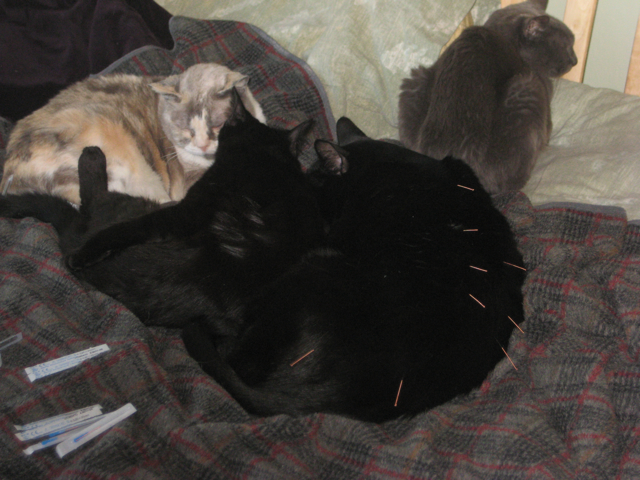
For anyone who ever asked,” how do you do acupuncture on a cat?”
Here is a good book on Chinese Medicine and acupuncture/acupressure for cats and dogs
Four Paws Five Directions: A Guide to Chinese Medicine for Cats and Dogs
My vet can no longer help! Who do I turn to now?
Wednesday, March 4th, 2009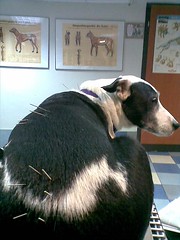 How do you decide where to turn when western medicine has run out of options? Almost everything available for humans is now available for animals but how do you decide between all the options. There are chiropractors, acupuncturists, reiki practitioners, homeopathic veterinarians, nutritional consultants, hydrotherapy specialists, massage practitioners, and many other options. If you read the internet there are hundreds of supplements made especially for animals and many sound like they work miracles.
How do you decide where to turn when western medicine has run out of options? Almost everything available for humans is now available for animals but how do you decide between all the options. There are chiropractors, acupuncturists, reiki practitioners, homeopathic veterinarians, nutritional consultants, hydrotherapy specialists, massage practitioners, and many other options. If you read the internet there are hundreds of supplements made especially for animals and many sound like they work miracles.
Here are a few tips –
 Because I practice acupuncture I often recommend it to start because I have seen how well it can work. Often times people start with a therapy for their animal that they have tried themselves and know to work. This is a good place to start. If something works for you, it probably will for your animal also.
Because I practice acupuncture I often recommend it to start because I have seen how well it can work. Often times people start with a therapy for their animal that they have tried themselves and know to work. This is a good place to start. If something works for you, it probably will for your animal also.
A good practitioner of any sort will be able to tell you how long to try something and when to decide if it is working or not. Most practitioners don’t want to go on treating with a method which is not working. With acupuncture I usually recommend three treatments to see if there is any improvement before recommending animals continue. Some therapies such as hydrotherapy will take a little longer. Always get this information before starting a therapy. And just because you try one thing and it doesn’t work, don’t give up. There are many incredible options out there for helping our animal friends.
Peace before differences-a dog, a rat and a cat
Sunday, March 1st, 2009
Anytime you great stuck in the impossible, think of these guys who have ended up as friends. Perhaps the true meaning of peace comes from not seeing our differences but seeing that in the end we are all the same.
In honor of spay day
Tuesday, February 24th, 2009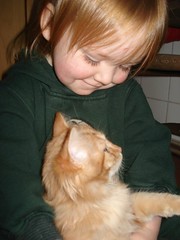 Today is spay day and in honor of this very important day my friend Rose DeDan wrote a beautiful and very moving article on her blog, Dare to Care, the Life You Save May Be Someone’s Future Pet. If you get the time please take a moment to read it.
Today is spay day and in honor of this very important day my friend Rose DeDan wrote a beautiful and very moving article on her blog, Dare to Care, the Life You Save May Be Someone’s Future Pet. If you get the time please take a moment to read it.
Many of you know that I spent my first three years as a veterinarian working at the Seattle Humane Society. While I consider it some of the most rewarding work I have done, I am still haunted by nightmares from the euthanasias I performed. It is never easy to take an animal’s life and although I think my work there saved far more animals then I had to kill it is still difficult for me. Many times I would end up curling up on the floor at home sobbing after having a particularly hard day.
I remember in particular a litter of five beautiful orange tabby kittens who came in with their mother and father, also very striking orange tabbies. The whole family of cats had been surrendered. We always tested every cat who came in for FeLV and the dad of this family came up positive. Because FeLV can be spread through drinking water and this whole family had been together they all had to be euthanized. My staff and I were heartbroken but there wasn’t anything we could do. It would take six months to know for sure if mom and the kittens were infected or not and we did not have the resources to keep them that long.
 I swallowed by emotion the best I could and euthanized dad and then took one kitten at a time away from mom and euthanized them. At the end I went back to get mom and couldn’t do it. I looked her in the eyes and realized that I had just killed her whole family and for the first time in my shelter career I just couldn’t. I ran back in tears and quickly explained that I needed to leave for a while, retreating to the bathroom to cry. Someone else took over and I didn’t have to face mom but I will always remember that day.
I swallowed by emotion the best I could and euthanized dad and then took one kitten at a time away from mom and euthanized them. At the end I went back to get mom and couldn’t do it. I looked her in the eyes and realized that I had just killed her whole family and for the first time in my shelter career I just couldn’t. I ran back in tears and quickly explained that I needed to leave for a while, retreating to the bathroom to cry. Someone else took over and I didn’t have to face mom but I will always remember that day.
Please, please spay or neuter your animals. I hope for a day when shelters will no longer have to euthanize animals and those who work there will be able to help without killing.
I have many tales I could tell about the animals on death row who passed through my bathroom as foster cats and went on to live and the two who never left and are still living with me. My very precious Melody and Rudy, both with chronic upper respiratory infections. But today I want to share my sadness in the hope that it helps prevent more unwanted animals from entering this world
The danger of compact fluorescent lighting
Saturday, February 21st, 2009 When I travel these days I always pack a four pack of incandescent light bulbs with me. Occasionally I will forget and then my first stop is always to the nearest Safeway or drug store to buy a pack. The more I hear about the possibility of a ban on these types of bulbs the more I worry. Should I start a stockpile of them in my basement now? Or have faith that LEDs will become more widespread before the ban or perhaps some new alternative will be developed.
When I travel these days I always pack a four pack of incandescent light bulbs with me. Occasionally I will forget and then my first stop is always to the nearest Safeway or drug store to buy a pack. The more I hear about the possibility of a ban on these types of bulbs the more I worry. Should I start a stockpile of them in my basement now? Or have faith that LEDs will become more widespread before the ban or perhaps some new alternative will be developed.
So why does this worry me?
Yes there is the concern about the mercury in CFLs, a known toxic substance. But what concerns me the most is that CFLs or compact fluorescent lighting makes me sick. I can be under it for a short period of time, say an hour or two, but that’s it. If I spend a day under CFLs (or in my case also the classic tube fluorescence lights), it usually takes me a day to get back to normal. My head hurts, I feel dizzy, I can’t hold thoughts, I feel drained yet I can’t sleep that evening, and I feel irritated and depressed.
I know I’m not the only one. I’ve talked to others who have similar problems and there have been some reports about CFLs increasing migrants, depression, and worsening symptoms in diseases such as Lupus. Traditionally healers, such as Barbara Ann Brennan, have long advised to never do healing work under fluorescence lighting of any kind to avoid making yourself ill. These lights drain our energy and especially for us in a healing profession this can be very dangerous.
Studies have also show that children do much better under normal lighting. From Earthwatch – Compact Fluorescents vs. Full Spectrum Bulbs
Elementary school Principal William Titoff, in his Ph.D. dissertation, found that “there was a statistically significant difference between students who worked under old-style fluorescent lights and those who worked under full-spectrum, visually-efficient lighting.” His study also found that depression was reduced among those students who studied under full spectrum lights and that it increased among fourth graders who sat under fluorescents.
A similar study, conducted in Florida in 1973 by light pioneer Dr. John Ott, found that students under fluorescents were more likely to be irritable, hyperactive, fatigued and have trouble paying attention. The students under full spectrum lights were better behaved and performed better academically within one month of the lights’ installation.
Here is another interesting letter to the editor about CFLs from Dr. Magda Havas, B.Sc. Ph.D a researcher in electromagnetic pollution from Trent University which explains part of the problem.
As Dr. Havas states –
Compact fluorescent lights (CFL) produce radio wave frequencies. These frequencies radiate directly from the bulbs and go on the electrical wiring in the home or school causing poor power quality or dirty electricity. The closer you sit to the bulb the greater your exposure. Because the high frequencies travel along the wire you can be exposed in other rooms of your home as well as the room that contains the CFL.
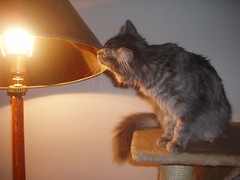 So why do I bring this up on an animal site?
So why do I bring this up on an animal site?
I worry as more and more people replace their traditional bulbs with CFLs that these new bulbs will affect the health of not just the people in the house, but also the animals. I am lucky enough to be able to tell that CFLs make me sick and do something about it, but how will you be able to tell if CFLs are making your animal sick? They cannot tell us if they are having headaches or just feeling bad.
Also new research has come to light that indicates that CFLs emit a high humming sound that is not in our range of hearing but is in the range of hearing of cats and dogs. Can you image hearing a high pitched humming sound all day long. It would be enough to drive you nuts! Many pet owners report that their cats or dogs do not want to be in rooms with CFL bulbs on and will become anxious if they are forced to be.
See the articles Don’t like CFLs? Ask your pet and CFL Bulbs: Save the Plant Make Your Pets Insane.
I ask you to consider alternatives to CFLs. In a few years the technology for LED lighting should be better and LEDs should be available for about the price of a normal bulb. LED bulbs last possibly forever (at least ten years or more) and use much less energy than CFLs. Most importantly they are safe! In the mean time keep your normal incandescent light bulbs. Even without taking the health effects of CFLs into consideration, we are going to have an environmental nightmare from the mercury in these light bulbs in a few years.
Also remember that if you break these light bulbs you need to be very cautious about how you go about cleaning up. You don’t need a full haz-mat team but some precautions are needed and make sure to get your animals and children out of the room immediately. Here’s the snopes.com article on what you do and don’t need to do.
1/30/12 I have now began replacing some of my bulbs with LEDs. The prices are starting to come down and the quality is getting better. The light quality is still not what it is with the incandescent light bulbs but much better than the CFLs in my opinion. Spending $80 on three light bulbs today I felt a little silly but they are supposed to last over twenty years and use about $1.00 of electricity a year, so overall I think it is a win. Plus since there are many places in our home that require ladders to reach I am excited that this may be the last time up on a ladder for a long time. Happy light bulb hunting!
11/16/13 LEDs have now come down in price and there are even better options like this $10 light bulb Lighting EVER 7W A19 LED Bulb. They even now make LEDs that can replace traditional fluorescent tubes like this one, LEDwholesalers Brightest LED Tube Fluorescent Tube Replacement
. I hope that we reach a day when CFLs are no longer made.
You are what you think
Wednesday, February 18th, 2009 We have all heard the saying , “you are what you eat”, but most people haven’t heard, “you are what you think.”
We have all heard the saying , “you are what you eat”, but most people haven’t heard, “you are what you think.”
Intention has an amazing role in healing and medicine. Even in Western medicine the power of intention and the placebo effect has been scientifically proven to exist.
Because of the placebo effect drug trials in people have to be double blinded, meaning that both the patient and the doctor administering the drug are not told if they have the real drug or the placebo.
Did you know that drug trials in animals also have to be double blinded? Obviously the animal doesn’t know if they are being given the real drug or not but the doctor or researcher also needs to have no knowledge of this. They have found that if the person administering the drug knows if it is the real drug or the placebo, then the results will be influenced by this knowledge.
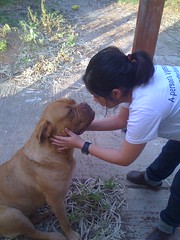 Yes there is a placebo effect in healing for animals but it is created through us! That’s pretty amazing when you think about it.
Yes there is a placebo effect in healing for animals but it is created through us! That’s pretty amazing when you think about it.
So how can can we use this power of intention in helping our animal friends heal?
Primarily we can believe that they can heal. If we have confidence that our animal companion can heal they can sense this and it will help them also believe in their own healing. When we think positive thoughts we release certain chemicals in our body which affect our nervous system in a positive way. This enhances our immune system and helps direct our body back to homeostasis.
Because our animals are deeply connected to us they are also calmer when we are positive and get the same positive immune and nervous system response. While we can often share disease with our animal friends, we can also share health.
Many studies have been done on the power of intention. One of the most well know was a study done on reducing crime by meditation and positive thought in Washington DC in the summer of 1993. Though meditation alone the rate of crime was dropped by almost 25%. A National Demonstration Project of Transcendental Meditation. Other studies have also been performed with similar results.
Here’s some simple exercises you can do to help your animal if they are sick
It is amazing to see how the little things we do can help our animal companions!
Here are links to three very good books and audio tracks on meditation
A Path with Heart: A Guide Through the Perils and Promises of Spiritual Life
Meditation for Beginners
How to Meditate with Pema Chodron: A Practical Guide to Making Friends with Your Mind
Pending Washington State Spay/neuter Legislation Could Save Thousands of Dogs’ and Cats’ Lives
Tuesday, February 17th, 2009 Thanks to Pamela for forwarding me this important legislation pending in Washington State.
Thanks to Pamela for forwarding me this important legislation pending in Washington State.
If you are in Washington State please check out Save Washington Pets for information on how to contact your lawmakers and support these bills.
Pawsitive Alliance, a volunteer organization devoted to ending the killing of adoptable dogs and cats in Washington state, is proud to support two bills currently in the Washington State Legislature: Senate Bill 5329 and House Bill 1406.
If passed, these bills would enable low-income owners to spay or neuter pets for a co-payment of only $10 for cats and $20 for dogs, likely resulting in a drastic reduction in the number of homeless dogs and cats living in Washington state shelters. Presently, shelters report that because of overcrowding, over 1,000 dogs and cats are euthanized every week in Washington.
The bills do not make spay/neuter surgery mandatory. Instead, they encourage people to spay/neuter their pets by making surgery affordable and accessible.
This aggressive statewide spay/neuter program would be funded by a fee paid by distributors who ship more than one ton of pet food in a six-month period. On the consumer end, the direct financial impact would
amount to less than a penny per meal for most pets. To put this in perspective, the fee’s direct cost would typically be less than $10 per year for a family with one dog and one cat.
Members of the community can easily and effortlessly support Pawsitive Alliance and 50 other animal welfare advocate groups in their efforts to make this crucial legislation happen by going to Save Washington Pets
For anyone who was outraged by the recent puppy mill seizure, cares about animals, believes that they should not be killed because of a problem with our system, or simply wants to save taxpayer money, now is the time to help in this small way!
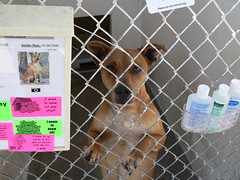 “Apart from the humane aspects, which should bother anyone, the cost of handling and euthanizing unwanted animals from litters is staggering—and less affordable than ever for many people in these difficult economic times,” said Washington Senator Craig Pridemore, the prime sponsor of SB 5329.
“Apart from the humane aspects, which should bother anyone, the cost of handling and euthanizing unwanted animals from litters is staggering—and less affordable than ever for many people in these difficult economic times,” said Washington Senator Craig Pridemore, the prime sponsor of SB 5329.
Pridemore points out several problems that could be solved by the legislation, “First, it reduces the number of unwanted animals that are needlessly killed each year. Second, at a time when many people are struggling to make ends meet, it helps those least able to afford to spay or neuter their pets. Third, it reduces shelter costs and frees up money to house strays until they can find homes, instead of destroying them.”
Eight other states have adopted similar spay/neuter programs for pets of low-income residents. After New Hampshire founded a comparable program in 1994, the state saw a 75-percent decrease in euthanasia and a 34-percent decrease in shelter admissions in its first few years. This is in addition to significant taxpayer savings from reduced animal impoundment costs due to the program.
“We’ve all seen the pictures of lonely pets in cages and without owners, and we know the only fate waiting for most of them is to be put down,” Pridemore said. “It doesn’t have to be that way. This is a problem we can solve for pennies.”
Cat scan for cancer
Tuesday, February 17th, 2009 I found this amazing story today, Cat nips owner’s lung cancer, about a cat named Tiger who diagnosed lung cancer in his person. He would not stop pawing the left side of this man’s chest which he mentioned to his doctor. They found a lung tumor right under where Tiger had been pawing! Because of Tiger’s quick action they were able to remove the tumor and it sounds like his person has a good chance of full recovery.
I found this amazing story today, Cat nips owner’s lung cancer, about a cat named Tiger who diagnosed lung cancer in his person. He would not stop pawing the left side of this man’s chest which he mentioned to his doctor. They found a lung tumor right under where Tiger had been pawing! Because of Tiger’s quick action they were able to remove the tumor and it sounds like his person has a good chance of full recovery.
It is amazing to me how acute animals’ sense of smell is and how they are willing to help us. There have been a number of accounts of dogs diagnosing cancer by smell although this is the first one I have seen involving a cat. Service dogs can detect when people are about to have seizures by smell making it so that people with epilepsy can live normal lives. We all know the tales of the search and rescue dogs who find people buried under buildings or in the snow. And of course there are also the drug and explosive sniffing dogs at the airports and ferry docks.
I have had clients mention that sometimes it is another animal in the house that detects illness in their animal companion long before that animal shows any signs we can see. I know if I wound myself, my dogs will usually find where and want to check it out.
Here is another interesting story about cancer sniffing dogs, Can Dogs Sniff Out Cancer?. Puts a whole new meaning to getting a cat scan (or in a dog scan)!

